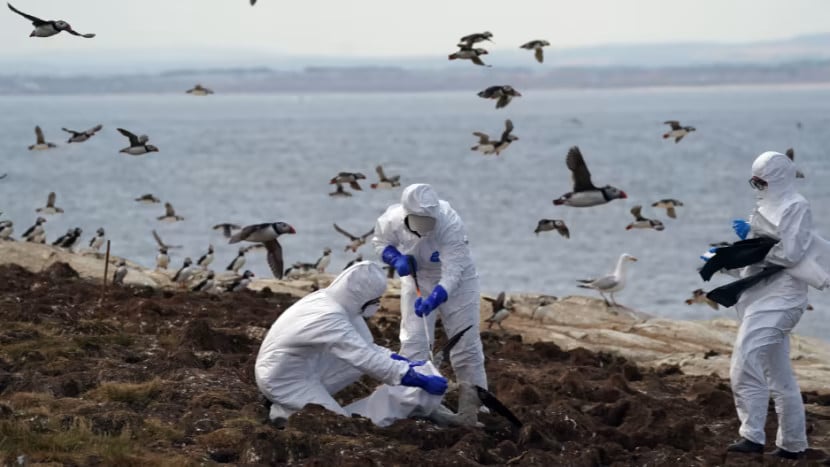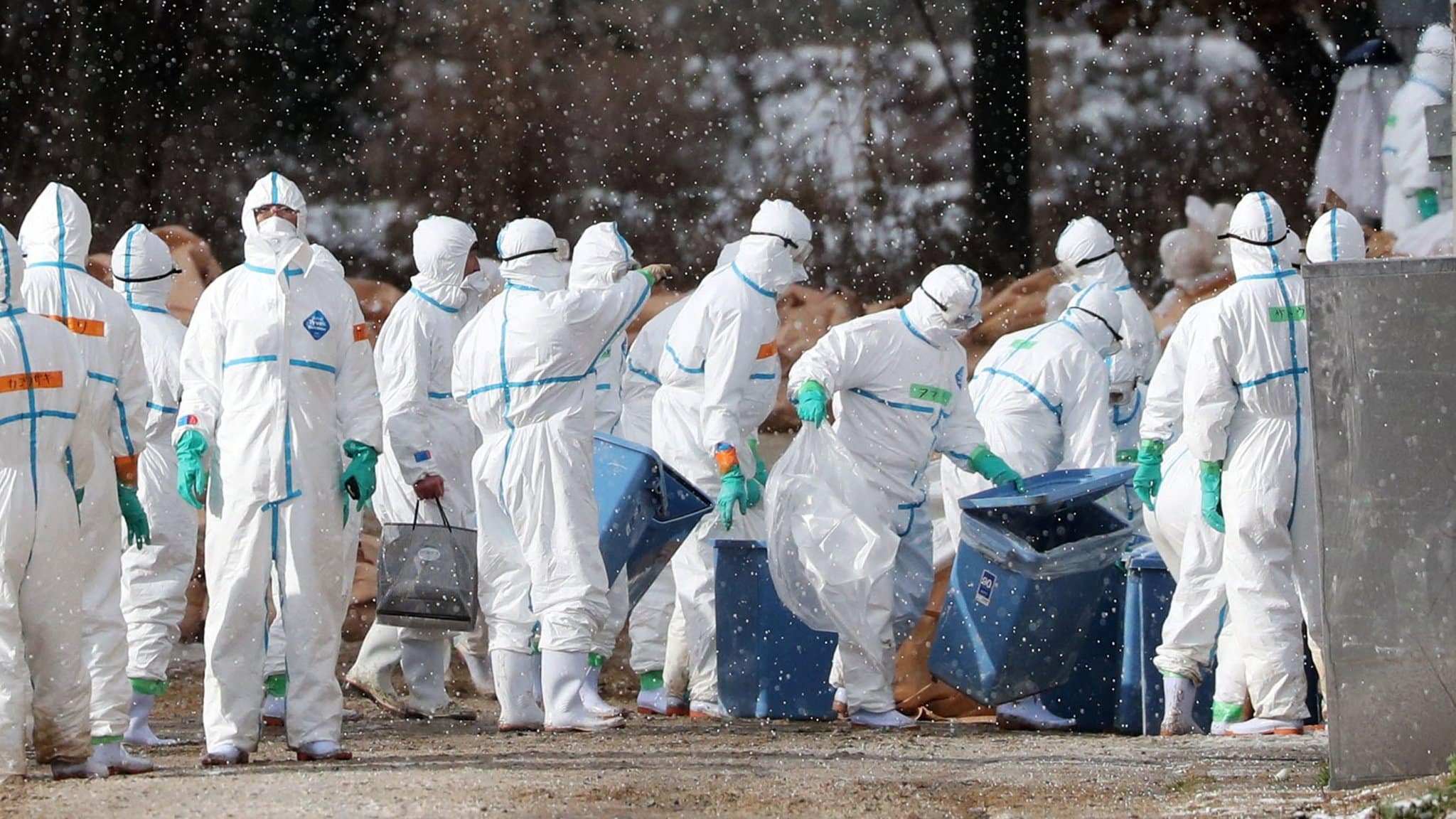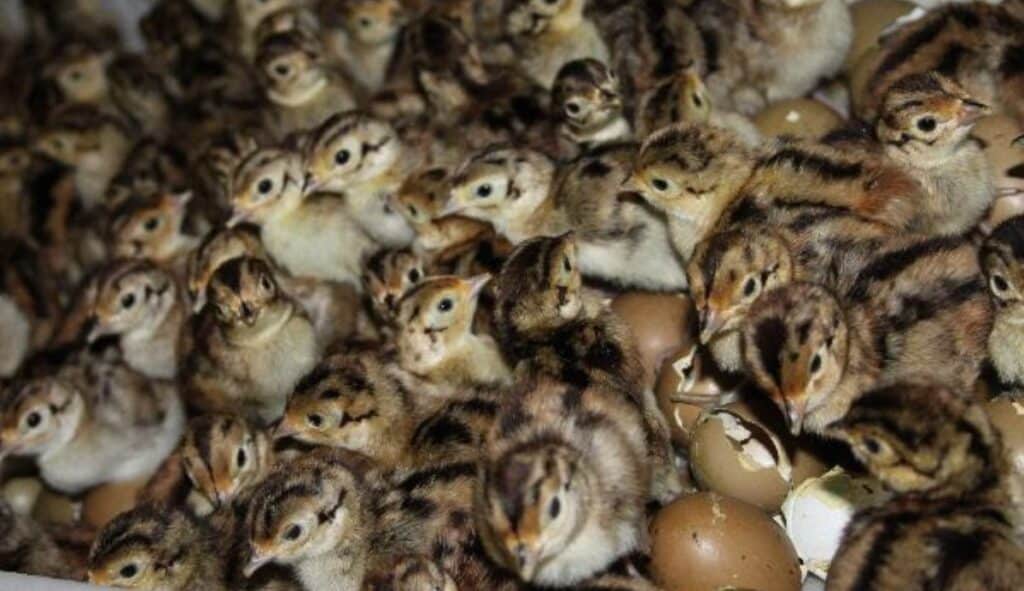Avian Flu protection zones have been imposed around a massive pheasant and partridge breeding farm in north Powys.
The family-owned Bettws Hall Game Farm, near Bettws Cedewain, which describes itself as ‘a market leader in the production of pheasant and partridge chicks and poults in the UK‘, says it raises more than 1.7m pheasant and partridge chicks a year which it sells to shooting estates to be killed for ‘fun’. It also manages six shooting estates with ‘luxury accommodation and catering’, and works with more than fifty contract rearing sites on the Powys and Shropshire borders.

The Welsh Government announced a 3km (1.8 mile) protection zone in the area on 13th April and a 10km (6.2 mile) surveillance zone was set up at the same time. Two further protection and surveillance zones covering almost the same area were then announced on 23 and 27 April.
The protection zone imposes strict biosecurity rules, including restrictions on the movement of poultry, eggs and slurry. Any vehicles which enter or leave a site must be disinfected and – most importantly – no birds can be released.
Avian Flu – a history of mismanagement
Avian Flu, or (HPAI) H5N1, is a highly contagious viral disease affecting the respiratory, digestive and/or nervous systems of many species of birds.
The disease originated in East Asia in infected chickens in the region’s vast, unsanitary poultry sheds where non-existent biosecurity (including the sluicing of faeces straight into local waterways) allowed the virus into the environment. Essentially contained within China, South Korea, and parts of Russia more than a decade ago, the virus has spread and in summer 2022 tore through populations of wild birds across Europe.
As we have detailed before, early reporting on the virus was often hyperbolic and focussed on an (almost non-existent) threat to the general public. The Guardian for instance reported as long ago as 2008 that “Britain faces 75,000 deaths in bird flu pandemic” and that the “Department of Health has stockpiled enough of the antiviral drug Tamiflu to cover a quarter of the population” in case a zoonotic disease like ‘bird flu’ transferred into people – leading to mass infections, high mortality, and overwhelmed hospitals etc (a warning that came a decade before Covid and was ignored anyway).
Current strains of Avian Flu are no more a risk to the public than previously and according to a World Health Organization report published on 4 November 2022, between 2003 (when the virus was first detected outside China) and 21 October 2022, there have been 868 cases of human infection with the avian influenza A(H5N1) virus of which 456 were fatal. The vast majority of these are poultry workersexposed to the dust from dried chicken faeces.
It is however deadly to birds. Vast numbers of chickens have been killed, and up to 500 million wild birds have died. Across Europe, populations of seabirds (which tend to breed in dense colonies) and birds of prey (which are more likely than other birds to scavenge infected carcasses) have been hit very hard indeed.
A government report in the House of Lords Library dated November 2022, quotes the director of policy at the RSPB, Jeff Knott, saying:
The severity of the situation and scale of the impact is unprecedented and very, very scary. It’s a huge crisis that could turn into a catastrophe unless we get ahead of it.
And on 31 October 2022, Dr Christine Middlemiss, the UK’s chief veterinary officer, said:
We are now facing, this year, the largest ever outbreak of bird flu and are seeing rapid escalation in the number of cases on commercial farms and in backyard birds across England.
In May 2023 The Guardian revealed that studies of data from devolved governments and nature organisations show that at least 50,000 wild birds had died of Avian Flu between October 2021 until the start of April 2023. They commented that this number is “still likely to be a gross underestimate as there is no national monitoring and most carcasses are never found and not counted“.
While the figures are small compared with the number of birds reared at places like Bettws Hall solely to be shot, they need to be understood in the context of previous studies that show that globally one in eight bird species are in danger of extinction, Europe has already lost around 600 million breeding birds since 1980 (one in six), and that the UK is already one of the most nature-depleted countries on the planet.

The shooting industry’s (lack of) reaction
It may come as a surprise to some people that breeding facilities as large as Bettws Hall Game Farm exist at all. But the industry’s desire for more live targets to shoot seems insatiable.
Its own figures suggest that the industry releases a staggering 50 million non-native pheasants and partridges into an already stressed environment every year. Millions of those birds will be shot for fun, millions will die on our roads, and an untold number will be scavenged (by the very mammals and birds the industry relentlessly persecutes in an effort to ‘restore balance’, an absolutely laughable proposition given the releases of so many non-native birds in the first place).
The industry has always looked at Avian Flu not as a serious risk to the environment and wild birds, but as a risk to an industry already facing demands for it to be shut down as raptor persecution continues, animal sentience and awareness becomes a live issue, and the scale of the biodiversity crisis becomes more apparent.
Back in late 2020 a well-known shooting site pondered the outbreak, concluding with a self-pitying whine that “…with Game Shooting due to restart in England on 3rd December, it is really important that nothing else threatens shoot days for the remainder of the season – it has after all, not been an easy one!”
Shooting, though, seemed determined to ignore its own potential role in the spread of Avian Flu, and business more or less continued as before – with inevitable results.
By the 22nd of September ITV News was reporting that ‘…for the first time this year pheasants in Cornwall, Cheshire and Norfolk have tested positive for the H5N1 virus’. While it was not possible to remove birds for testing, around the same time a Protect the Wild funded investigation by the Hunt Investigation Team of a shoot in Lancashire just a few miles from the internationally important nature reserves of Leighton Moss and Morecambe Bay uncovered a dystopian scenario of young pheasants showing signs of Avian Flu and being plucked alive by other birds.
By November 2022 the British Trust for Ornithology (the BTO) had published a report (‘Highly pathogenic avian influenza in wild birds in the United Kingdom in 2022: impacts, planning for future outbreaks, and conservation and research priorities‘) which collated data from a number of workshops. One of the points raised was the “Potential role of gamebird/waterbird releases to introduce HPAI into the environment from reared populations. This is considered especially
important to understand for raptors.”

Whatever happened to the ‘precautionary principle’?
Back in 2014 the Korean NGO Birds Korea (which has spent years looking into Avian Flu), said that “Based on the best available scientific evidence, we continue to believe that it is the industrial production and movement of poultry that has created the conditions required to maintain and spread strains of Highly Pathogenic Poultry Flu; it is the modern poultry industry that causes enormous suffering for billions of animals; and it is the modern poultry industry that has led to a substantial increase in outbreaks of Poultry Flu in wild birds.”
Lessons clearly haven’t been learned as local news reported in November 2022 that a case of the H5N1 virus found at a farm in Hwaseong, 40 kilometers south of the capital Seoul, was “the 16th highly pathogenic bird flu case from a poultry farm in the country this autumn season.
The question now has to be, could the intensive shooting industry now become as important a vector in maintaining and spreading HPA1 here?
It would at the very least be sensible to take every precaution, but the government has so far refused to mandate a complete ban on releasing millions of birds for a few hobbyists to kill, despite the risk. It is clearly more interested in securing support from shooters than it is from the vast majority of the population that doesn’t own a gun and doesn’t want to spend a day slaughtering wildlife.
Massive pressure to lift restrictions will be put on all UK governments in the run-up to the mass releases of pheasants and partridges before the next scheduled ‘slaughter season’ starts again in October. Their response will undoubtedly hinge on infection rates in wild birds this summer, but with outbreaks already confirmed in major staging sites like the Gambian coast which is used by vast numbers of birds migrating along the East Atlantic Flyway and Avian Flu being suspected in a large colony of Black-headed Gulls last month the outlook is dire.
The government’s own Environmental principles (updated in Jan 2023) state that having ‘committed that we will be the first generation to leave the environment in a better state than that in which we found it’ they determine that ‘where there are threats of serious or irreversible environmental damage, a lack of full scientific certainty shall not be used as a reason for postponing cost-effective measures to prevent environmental degradation‘.
In other words, there is no need to wait until the last data point is collected: when things are this obvious act now before it’s too late.
Shooting is already a disgusting blight, but it would be an unforgivable act of selfishness and stupidity were it to release millions of potentially infected non-native birds for the gun and thereby risk the lives of millions of wild birds too.


